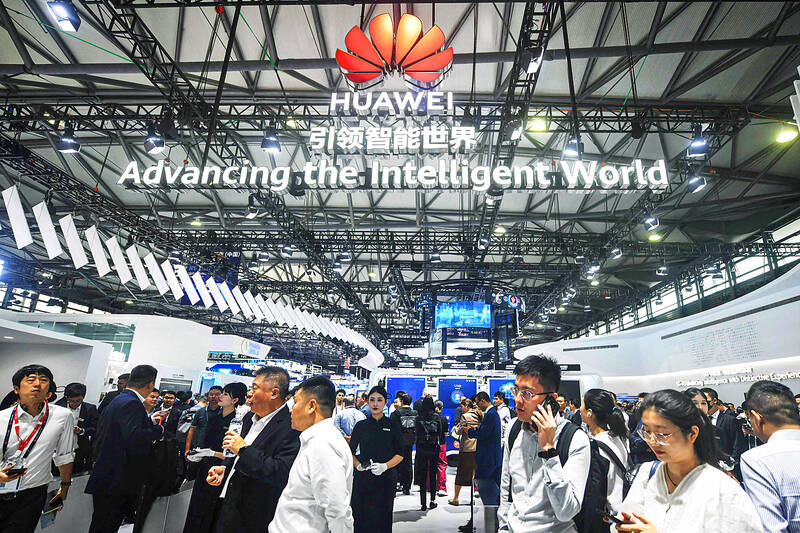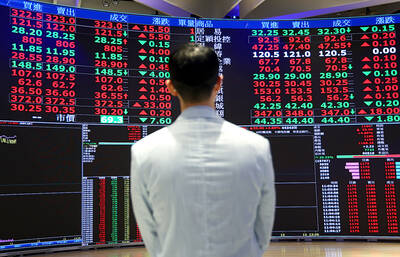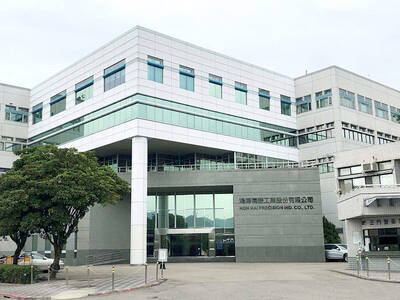Packed into a small room, a drone, bipedal robot, supermarket checkout and other devices showcase a vision of China’s software future — one where an operating system developed by national champion Huawei (華為) has replaced Windows and Android.
The collection is at the Harmony Ecosystem Innovation Center in the southern city of Shenzhen, a local government-owned entity that encourages authorities, companies and hardware makers to develop software using OpenHarmony (鴻蒙), an open-source version of the operating system Huawei launched five years ago after US sanctions cut off support for Google’s Android.
While Huawei’s recent strong-selling smartphone launches have been closely watched for signs of advances in China’s chip supply chain, the company has also quietly built up expertise in sectors crucial to Beijing’s vision of technology self-sufficiency, from operating systems to in-vehicle software.

Photo: AFP
Chinese President Xi Jinping (習近平) last year told the Chinese Communist Party’s elite politburo that China must wage a difficult battle to localize operating systems and other technology “as soon as possible,” as the US cracks down on exports of advanced chips and other components.
OpenHarmony is being widely promoted within China as a “national operating system,” amid concerns that other major companies could be severed from the Microsoft Windows and Android products upon which many systems rely.
“This strategic move will likely erode the market share of Western operating systems like Android and Windows in China, as local products gain traction,” Jamestown Foundation associate fellow Sunny Cheung said.
In the first quarter of this year, Huawei’s HarmonyOS, the company’s in-house version of the operating system, surpassed Apple’s iOS to become the second best-selling mobile operating system in China behind Android, research firm Counterpoint said. It has not been launched on smartphones outside China.
Huawei no longer controls OpenHarmony, having gifted its source code to a nonprofit called the OpenAtom Foundation (開放原子開源基金會) in 2020 and 2021, an internal memo and other releases said.
The growth of HarmonyOS, expected to be rolled out in a PC version this year or next, would spur adoption of OpenHarmony, analysts said.
“Harmony has created a powerful foundational operating system for the future of China’s devices,” Huawei consumer business group chairman Richard Yu (余承東) said last week.
Huawei first unveiled Harmony in August 2019, three months after Washington placed it under trade restrictions over alleged security concerns. Huawei denies its equipment poses a risk.
Since then, China has stepped up its self-sufficiency efforts, cutting itself off from the main code sharing hub Github and championing a local version, Gitee.
China banned the use of Windows on government computers in 2014 and they now use mostly Linux-based operating systems.
Originally built on an open source Android system, this year Huawei launched its first “pure” version of HarmonyOS that no longer supports Android-based apps, in a move that further bifurcates China’s app ecosystem from the rest of the world.
OpenAtom appeared to be coordinating with Chinese firms to develop a viable alternative to US technologies, including for defense applications such as satellites, a report from Jamestown Foundation last month said.
OpenHarmony last year was the fastest-growing open-source operating system for smart devices, with more than 70 organizations contributing to it, and more than 460 hardware and software products built across finance, education, aerospace and industry, Huawei said in its annual report last year.
Key OpenHarmony developers include Shenzhen Kaihong Digital (深圳開鴻數字), headed by Wang Chenglu (王成錄), a former Huawei employee known as Harmony’s “godfather,” and Chinasoft.
Both have worked on infrastructure software, at Tianjin Port and for mines in China’s top coal-producing province, Shaanxi.

Shares in Taiwan closed at a new high yesterday, the first trading day of the new year, as contract chipmaker Taiwan Semiconductor Manufacturing Co (TSMC, 台積電) continued to break records amid an artificial intelligence (AI) boom, dealers said. The TAIEX closed up 386.21 points, or 1.33 percent, at 29,349.81, with turnover totaling NT$648.844 billion (US$20.65 billion). “Judging from a stronger Taiwan dollar against the US dollar, I think foreign institutional investors returned from the holidays and brought funds into the local market,” Concord Securities Co (康和證券) analyst Kerry Huang (黃志祺) said. “Foreign investors just rebuilt their positions with TSMC as their top target,

REVENUE PERFORMANCE: Cloud and network products, and electronic components saw strong increases, while smart consumer electronics and computing products fell Hon Hai Precision Industry Co (鴻海精密) yesterday posted 26.51 percent quarterly growth in revenue for last quarter to NT$2.6 trillion (US$82.44 billion), the strongest on record for the period and above expectations, but the company forecast a slight revenue dip this quarter due to seasonal factors. On an annual basis, revenue last quarter grew 22.07 percent, the company said. Analysts on average estimated about NT$2.4 trillion increase. Hon Hai, which assembles servers for Nvidia Corp and iPhones for Apple Inc, is expanding its capacity in the US, adding artificial intelligence (AI) server production in Wisconsin and Texas, where it operates established campuses. This

H200 CHIPS: A source said that Nvidia has asked the Taiwanese company to begin production of additional chips and work is expected to start in the second quarter Nvidia Corp is scrambling to meet demand for its H200 artificial intelligence (AI) chips from Chinese technology companies and has approached contract manufacturer Taiwan Semiconductor Manufacturing Co (TSMC, 台積電) to ramp up production, sources said. Chinese technology companies have placed orders for more than 2 million H200 chips for this year, while Nvidia holds just 700,000 units in stock, two of the people said. The exact additional volume Nvidia intends to order from TSMC remains unclear, they said. A third source said that Nvidia has asked TSMC to begin production of the additional chips and work is expected to start in the second

US President Donald Trump on Friday blocked US photonics firm HieFo Corp’s US$3 million acquisition of assets in New Jersey-based aerospace and defense specialist Emcore Corp, citing national security and China-related concerns. In an order released by the White House, Trump said HieFo was “controlled by a citizen of the People’s Republic of China” and that its 2024 acquisition of Emcore’s businesses led the US president to believe that it might “take action that threatens to impair the national security of the United States.” The order did not name the person or detail Trump’s concerns. “The Transaction is hereby prohibited,”